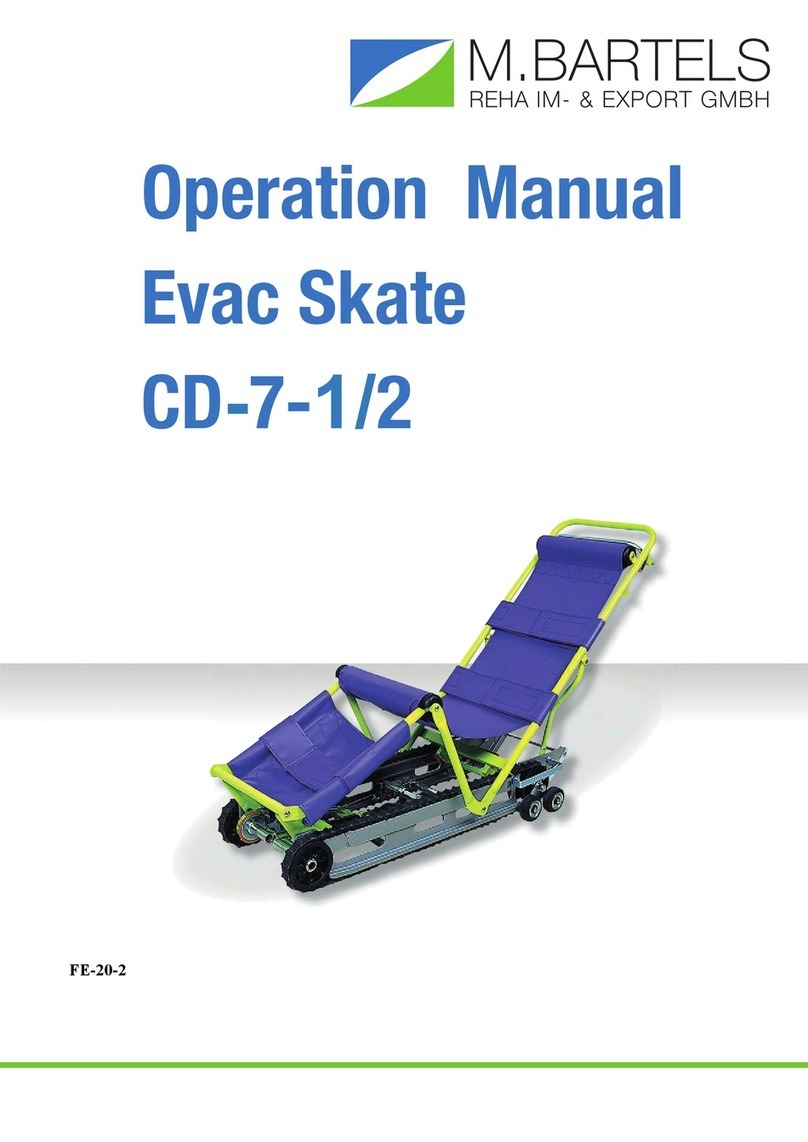
5
LOCATIONS OF SAFETY WARNING LABELS
CAUTION
Neglecting following indication may csse
accident:
1. Before running the machine, be sure to
read the operation manual carefully an
comprehend each function
2. Before running the machine, be sure to
do the safety check.
3. Before running the machine, be sure
to pay attention to safety around the
machine.
WARNING
Without securing wheelchair on the platform by the
wheelchair and passenger may fall and result in a
serious accident.
WARNING
1. Turn off key switch when not in use to
avoid unexpected discharge.
2. To run on flat surface, select the
GROUND mode, then press and hold
either OPERATION SWITCH on right or
left side to make sure free steering. To
activate the PARKING BRAKE, lift finger
off OPERATION SWITCH
3. Select the TRANSFER mode to load
wheelchair.
4. To ascend/descend the stairs, select the
Stair mode and select UP/DOWN direc-
tion, then press and hold both OERATION
SWITCHES to start trip.
5. Make sure to place the machine at right
angle (90 deg.) to the stairs during ascen-
ding / descending for fear of falling.
6. Do not use in the following stairs for
fear of falling. Stairs with excessive
rounded step noses such as R 9mm or
under). Stairs including any irregular step.
Slippery stair with wet, oily and other
condition.
7. When the machine comes to the top
steps in ascending, see to confirm the
Rail Frames are bent to land. If you find
the rail Frames still keep straight at the
top step, press and hold the Bent mode
to make sure the Rail frames are bent
before landing.
8. When you have to bent the Rail Frame in
the middle of stairs, bent it carefully for
fear of disturbing stability on the stairs.
MANUAL MODE SWITCH
1. These switches and buttons are for only adjust-
ment or checking procedure.
2. Select the Manual mode to activate these switches
and buttons, select Manual mode. After finishing
adjustment and checking procedure, select again
Auto mode.
WARNING
Never touch any moving parts while
Rubber Crawler is running, otherwise
passenger or attendant may be injured
or died.
WARNING
Never touch any moving parts
while Rubber Crawler is running,
otherwise passenger or attendant
may be injured or died.
CAUTION
Notice in acsending:
When the machine comes to the top steps,
the rail frame may not be bent in following
cases. In case the detection of the sensor
is obstructed by something for example
operator´s leg etc. In case the finish of sur-
face has quite well-reflection or black color.
Notice decending:
Never pull back the handles when the
machine approaches top steps, it may
disturb the stable running.
Detection Range
Don`t pull back
Desending
Stairs Landing
WARNING For fear of falling, the front casters of wheelchair
must not be placed beyond this line
Do not load on the Ramp except for loading wheelchair.
5
1
To maintain safe operation, important safety precautions, classied into Danger, Warning and Caution, are
indicated in corresponding parts of the operation manual. The denition of each precaution is explained in
the following section.
SAFETY PRECAUTIONS
Neglecting this warning indication or operating the machine
improperly may seriously endanger the concerned person’s
health or life.
Neglecting this warning indication or operating the machine
improperly may cause serious personal injury or even death.
Neglecting this warning indication or operating the machine
improperly may cause injury to the concerned person or damage
the machine or related items.
Safety Warning Labels
• For safe use, be sure to read and follow the precautions on all safety warning labels placed on the machine.
• Replace any safety warning label if it is damaged, missing, or illegible.
• If you require replacement labels, contact the distributor from which you made your initial purchase.
WARNING
SAFETY PRECAUTIONS
CAUTION
38
AFTER-PURCHASE SERVICING
15.
15.
AFTER-PURCHASE SERVICING
●Warranty and repair
1) The term of the warranty is one year from the purchase date. The distributor from which you made a
purchase will repair your product.
Even during this period, in the following cases, repair expenses have to be paid.
a. Malfunction or damage due to erroneous usage or improper repair or alteration
b. Malfunction resulting from fire, earthquake, flood, lightning, or other natural disasters or
environmental pollution
c. Malfunction due to the usage of the battery, oil, battery charger, etc., other than specied
d. Consumable items such as Battery Packs, Rubber Crawlers, and oil
e. Usage in foreign countries
2) As for repair after the expiration of the warranty term, please consult your sales agent. As far as repair is
possible, we will perform repairs upon your request and at your expense.
●Retention period of parts for repair
1) We retain the parts necessary for the maintenance of the product for at least seven years after the
termination of the production of the product.
2) For any unclear matters concerning the product or after-purchase servicing, please ask your sales agent.
●In case you wish to scrap this product
Please contact your sales agent or SUNWA LTD.
5




























